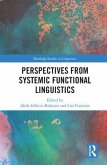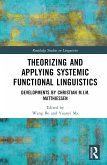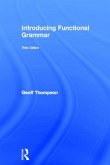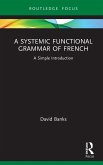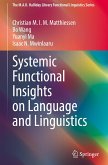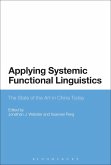Introducing Systemic Functional Linguistics
Theory, Description and Application
Herausgeber: Yu, Hui; Wang, Bo; Chang, Chenguang
Introducing Systemic Functional Linguistics
Theory, Description and Application
Herausgeber: Yu, Hui; Wang, Bo; Chang, Chenguang
- Gebundenes Buch
- Merkliste
- Auf die Merkliste
- Bewerten Bewerten
- Teilen
- Produkt teilen
- Produkterinnerung
- Produkterinnerung
This book provides a comprehensive introduction to Systemic Functional Linguistics (SFL), covering key concepts and contributions to the field, and instructing beginners to apply SFL to different areas.
Andere Kunden interessierten sich auch für
![Perspectives from Systemic Functional Linguistics Perspectives from Systemic Functional Linguistics]() Perspectives from Systemic Functional Linguistics204,99 €
Perspectives from Systemic Functional Linguistics204,99 €![Theorizing and Applying Systemic Functional Linguistics Theorizing and Applying Systemic Functional Linguistics]() Theorizing and Applying Systemic Functional Linguistics167,99 €
Theorizing and Applying Systemic Functional Linguistics167,99 €![Introducing English for Academic Purposes Introducing English for Academic Purposes]() Diane PecorariIntroducing English for Academic Purposes179,99 €
Diane PecorariIntroducing English for Academic Purposes179,99 €![Introducing Functional Grammar Introducing Functional Grammar]() Geoff ThompsonIntroducing Functional Grammar151,99 €
Geoff ThompsonIntroducing Functional Grammar151,99 €![A Systemic Functional Grammar of French A Systemic Functional Grammar of French]() David BanksA Systemic Functional Grammar of French74,99 €
David BanksA Systemic Functional Grammar of French74,99 €![Systemic Functional Insights on Language and Linguistics Systemic Functional Insights on Language and Linguistics]() Christian M.I.M. MatthiessenSystemic Functional Insights on Language and Linguistics91,99 €
Christian M.I.M. MatthiessenSystemic Functional Insights on Language and Linguistics91,99 €![Applying Systemic Functional Linguistics Applying Systemic Functional Linguistics]() Applying Systemic Functional Linguistics143,99 €
Applying Systemic Functional Linguistics143,99 €-
-
-
This book provides a comprehensive introduction to Systemic Functional Linguistics (SFL), covering key concepts and contributions to the field, and instructing beginners to apply SFL to different areas.
Produktdetails
- Produktdetails
- Verlag: Routledge
- Seitenzahl: 352
- Erscheinungstermin: 12. September 2025
- Englisch
- Abmessung: 240mm x 161mm x 23mm
- Gewicht: 693g
- ISBN-13: 9781032852584
- ISBN-10: 1032852585
- Artikelnr.: 73390959
- Herstellerkennzeichnung
- Libri GmbH
- Europaallee 1
- 36244 Bad Hersfeld
- gpsr@libri.de
- Verlag: Routledge
- Seitenzahl: 352
- Erscheinungstermin: 12. September 2025
- Englisch
- Abmessung: 240mm x 161mm x 23mm
- Gewicht: 693g
- ISBN-13: 9781032852584
- ISBN-10: 1032852585
- Artikelnr.: 73390959
- Herstellerkennzeichnung
- Libri GmbH
- Europaallee 1
- 36244 Bad Hersfeld
- gpsr@libri.de
Hui Yu is a Professor in the School of Foreign Languages and Literature, Beijing Normal University, China. She has published extensively in areas including genre analysis (Essentials to Genre Analysis, 2018), Systemic Functional Grammar, academic writing, and knowledge structure (research grant by Ministry of Education: A comparative study of knowledge structure across different educational discourses). Chenguang Chang is a Professor of Linguistics in the School of International Studies, Sun Yat-sen Univesity, China. His recent publications include Linguistic Sustainability (co-edited with Yu Changsen, 2020) and Critical Discourse and Corpus Approaches to Systemic Functional Grammar (co-edited with Josef Schmied and Matthias Hofmann, 2021). Bo Wang is a researcher in Nanaimo, British Columbia, Canada. He is the co-author of Lao She's Teahouse and Its Two English Translations (Routledge, 2020), Systemic Functional Translation Studies (2021), Introducing M.A.K. Halliday (Routledge, 2022), and Systemic Functional Insights on Language and Linguistics (2022). Yuanyi Ma is currently a researcher in the Faculty of Education, Vancouver Island University, Canada. She is the co-author of Translating Tagore's Stray Birds into Chinese (Routledge, 2021) and co-editor of Key Themes and New Directions in Systemic Functional Translation Studies (Routledge, 2022) and Theorizing and Applying Systemic Functional Linguistics: Developments by Christian M.I.M. Matthiessen (Routledge, 2024).
Part 1: Theory and description
1. Getting started: What is Systemic Functional Linguistics?
Hui Yu
2. TRANSITIVITY: How do we construe our experiences?
Zhiying Xin
3. MOOD: How do we interact with each other?
Dongbing Zhang
4. MODALITY: Is it likely or is it desirable?
Yingmei Qu
5. APPRAISAL: How do we express our attitudes?
Chenguang Chang
6. Theme and information structure: How do we organize our messages?
Yong Wang
7. Cohesion: How are different parts of a text connected?
Man Zhang
8. Groups and phrases: What are their functions?
Bingjun Yang
9. Clause complex: How do we combine clauses?
Linxiu Yang & Lei Zeng
10. Grammatical metaphor: How can lexicogrammatical resources be expanded?
Yanning Yang & Chenguang Chang
11. Register: How does language use vary in different contexts?
Yanmei Gao
Part 2: Applications
12. Systemic Functional Linguistics and translation studies
Bo Wang, Christian M.I.M. Matthiessen & Yuanyi Ma
13. Systemic Functional Linguistics and multimodality
Dezheng (William) Feng
14. Systemic Functional Linguistics and language education
Xiaotang Cheng
1. Getting started: What is Systemic Functional Linguistics?
Hui Yu
2. TRANSITIVITY: How do we construe our experiences?
Zhiying Xin
3. MOOD: How do we interact with each other?
Dongbing Zhang
4. MODALITY: Is it likely or is it desirable?
Yingmei Qu
5. APPRAISAL: How do we express our attitudes?
Chenguang Chang
6. Theme and information structure: How do we organize our messages?
Yong Wang
7. Cohesion: How are different parts of a text connected?
Man Zhang
8. Groups and phrases: What are their functions?
Bingjun Yang
9. Clause complex: How do we combine clauses?
Linxiu Yang & Lei Zeng
10. Grammatical metaphor: How can lexicogrammatical resources be expanded?
Yanning Yang & Chenguang Chang
11. Register: How does language use vary in different contexts?
Yanmei Gao
Part 2: Applications
12. Systemic Functional Linguistics and translation studies
Bo Wang, Christian M.I.M. Matthiessen & Yuanyi Ma
13. Systemic Functional Linguistics and multimodality
Dezheng (William) Feng
14. Systemic Functional Linguistics and language education
Xiaotang Cheng
Part 1: Theory and description
1. Getting started: What is Systemic Functional Linguistics?
Hui Yu
2. TRANSITIVITY: How do we construe our experiences?
Zhiying Xin
3. MOOD: How do we interact with each other?
Dongbing Zhang
4. MODALITY: Is it likely or is it desirable?
Yingmei Qu
5. APPRAISAL: How do we express our attitudes?
Chenguang Chang
6. Theme and information structure: How do we organize our messages?
Yong Wang
7. Cohesion: How are different parts of a text connected?
Man Zhang
8. Groups and phrases: What are their functions?
Bingjun Yang
9. Clause complex: How do we combine clauses?
Linxiu Yang & Lei Zeng
10. Grammatical metaphor: How can lexicogrammatical resources be expanded?
Yanning Yang & Chenguang Chang
11. Register: How does language use vary in different contexts?
Yanmei Gao
Part 2: Applications
12. Systemic Functional Linguistics and translation studies
Bo Wang, Christian M.I.M. Matthiessen & Yuanyi Ma
13. Systemic Functional Linguistics and multimodality
Dezheng (William) Feng
14. Systemic Functional Linguistics and language education
Xiaotang Cheng
1. Getting started: What is Systemic Functional Linguistics?
Hui Yu
2. TRANSITIVITY: How do we construe our experiences?
Zhiying Xin
3. MOOD: How do we interact with each other?
Dongbing Zhang
4. MODALITY: Is it likely or is it desirable?
Yingmei Qu
5. APPRAISAL: How do we express our attitudes?
Chenguang Chang
6. Theme and information structure: How do we organize our messages?
Yong Wang
7. Cohesion: How are different parts of a text connected?
Man Zhang
8. Groups and phrases: What are their functions?
Bingjun Yang
9. Clause complex: How do we combine clauses?
Linxiu Yang & Lei Zeng
10. Grammatical metaphor: How can lexicogrammatical resources be expanded?
Yanning Yang & Chenguang Chang
11. Register: How does language use vary in different contexts?
Yanmei Gao
Part 2: Applications
12. Systemic Functional Linguistics and translation studies
Bo Wang, Christian M.I.M. Matthiessen & Yuanyi Ma
13. Systemic Functional Linguistics and multimodality
Dezheng (William) Feng
14. Systemic Functional Linguistics and language education
Xiaotang Cheng


